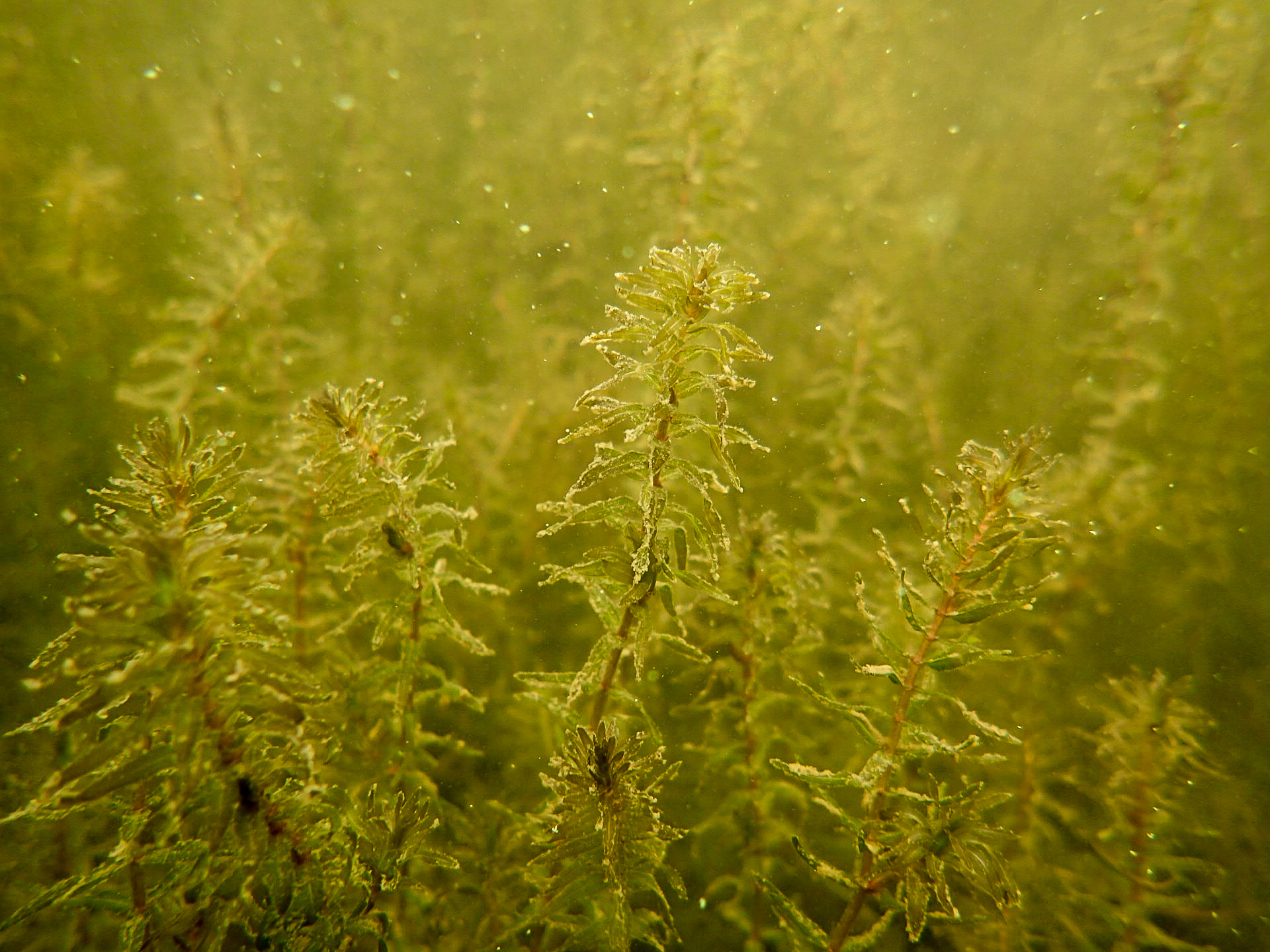
Water Weed have become an increasing menace to natural waterways as they block passage and reduce oxygen levels. Furthermore, many backyard fish ponds and home aquarium plants have introduced unwanted weeds into our environment.
Preventive measures are key in controlling weeds. Control methods include pulling, cutting, and herbicides.
This Water Weed Guide is designed to help pond owners identify and manage aquatic weeds and algae in their lakes and ponds. Management of most aquatic plant species depends on properly identifying the desirable or nuisance plant. Our aquatic weed control product recommendations are based on over thirty years of field experience with the do-it-yourselfer in mind. These are general recommendations that typically work when used according to the product label. Our biologists may choose to use other products and solutions when on site as the water chemistry of each pond is unique. We also carry products to rid your property of nuisance geese.
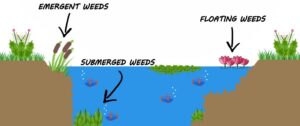
The following pages picture common aquatic weeds throughout the country. Place your weed in a clear glass jar with water and compare it to the pictures. Pay careful attention to the leaves. Keep in mind prior to implementing any control method that plants are a necessary and beneficial component of healthy pond ecosystems. Nevertheless, plants can cause problems and control measures to eliminate or reduce overabundance are available.
To get started, identify the group of aquatic weeds to which you feel your problem weed belongs and work through the examples until you find it. Refer to the aquatic weed zone map if unsure which group of aquatic weeds your issue belongs to.
Giant Salvinia
Salvinia molesta, commonly referred to as water fern or Kariba weed, is an aquatic weed that forms dense mats on lakes and streams, obstructing their surfaces with dense mats of leaves that choke out native vegetation, degrade water quality for fish and other organisms, limit boating, swimming, fishing and recreational activities, as well as block water intakes for irrigation and electricity production. It grows quickly and can form massive swaths that choke out native vegetation while degrading water quality for fish and other organisms in lakes and streams alike – further worsening water quality for fish and other organisms that inhabit these waters while restricting boating, swimming swimming swimming as recreational activities like boating or even stopping electricity production from taking place.
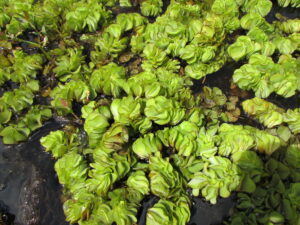
This species was initially discovered in 1998 in Toledo Bend Reservoir on the Texas-Louisiana border and since has been found in 34 other bodies of water throughout Louisiana. It can be distinguished from its smaller relative, Salvinia minima, by the unique configuration of its hairs covering each leaf surface; those belonging to giant salvinia split four ways before rejoining to form an eggbeater shape while common salvinia does not.
Giant Salvinia can be controlled using both cultural and chemical measures. Monitoring for this invasive plant is critical in order to identify new populations, manage existing infestations and stop further spreading to new water bodies. Furthermore, inspecting commercial ponds and water garden supplies regularly could reduce accidental spread by eliminating unintentional distribution into new bodies of water.
Water Milfoil
Eurasian Water-milfoil (Myriophyllum spicatum) is one of the most widespread submersed aquatic plants in North America. Covering thousands of miles each year and invading virtually all states and Canadian provinces through ship ballast or aquarium trade accidentally. Creating dense mats which strangle native species while creating unsuitable environments for many fish species and other wildlife. Reproducing through seed, fragmentation and root sprouting as well as hybridization with its northern cousin M. sibiricum to produce hybrids with intermediate characteristics that further spread its reach throughout freshwater lakes. Streams and rivers and can even tolerate brackish environments. Introduced accidentally into America through ship ballast or aquarium trade accidental introduction.
Now spread into virtually all states and Canada by its native cousin northern milfoil M. sibiricum hybridization can result in M x spicatum hybrids with intermediate characteristics – though introduced accidentally into US waters via ship ballast or aquarium trade accidentally introduced accidentally during shipping incidents or in aquarium trade accidentally introduced accidentally via ship ballast or aquarium trade accidental introduction has spread widely through nearly all states and Canada as it spread rapidly throughout.
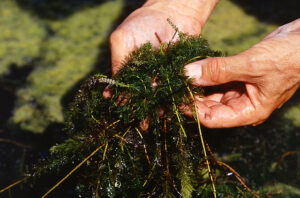
Fluridone can be found growing in golf courses, commercial marinas and residential ponds across North America and Europe, and online plant portals and aquatic nursery suppliers sell it too. Looking similar to native water-milfoil, this perennial herb survives temperatures as low as freezing over.
Chemical control options available include using herbicides like fluridone to achieve season-long control with just one application – meaning no restrictions for swimming, fishing or boating are imposed by its application – unlike with native species which must be continuously treated throughout its spread across its environment if that happens again next spring!
Water Hyacinth
Water hyacinth thrives in shallow waters, muddy banks, and lakeshores where light penetration is low. Quickly forming dense mats that shade out native aquatic vegetation and restrict sunlight, oxygen exchange, gas exchange at the water surface as well as impacting ecology of lakes by decreasing diversity of phytoplankton and aquatic vertebrates. Furthermore, recreational use is reduced significantly while navigation channels, hydropower production and irrigation may all become compromised as a result.
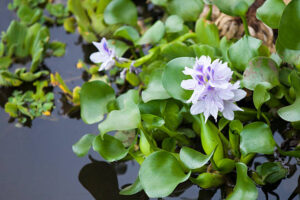
The plant is an aggressive breeder that spreads by seeds and stolons. It flourishes year-round in mild climates. Producing massive seeds with up to 20-year viability that remain viable after dispersal by wind, boat trailers and fishing gear.
At present, plants can be managed using physical, chemical and biological methods. Physical methods include harvesting manually removed plants as well as using machines to cut, pull or crush plant material. Harvesting and manually removed plants along with using machines to cut. Pull or crush the material are examples of physical methods. Chemical such as glyphosate, diquat 2,4-D amine metsulfuron-methyl and sulfosate. Can be used to kill off certain types of weeds while biological control makes use of weevils (Neochetina bruchi and Neochetina eichhorniae).
Blue-Green Algae
Blue-green algae blooms produce neurotoxins (neurotoxins) and liver toxins (hepatotoxins). Signs of poisoning for humans may include numb lips or tingling fingers and toes. In animals symptoms could include weakness, staggering, difficulty breathing. Convulsions and/or death. Water samples can be tested in an analytical lab for any presence of neuro- and/or hepatotoxins. It’s best to avoid skin contact with lakes and rivers until laboratory analyses show they’re safe.
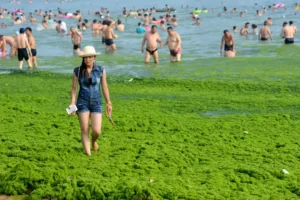
This non-native aquatic weed, with leaves that resemble lasagna noodles. Can create dense mats that interfere with oxygen levels in ponds and lakes. Crowding out native species while creating habitat for migrating birds and aquatic invertebrates. Copper algaecide treatments may help control this non-native plant.
NSW has invested in state programs to control the spread of invasive species like weeds. These efforts focus on education and awareness campaigns, community engagement efforts and developing water management strategies. Their goal being to keep many river systems free of major infestations that affect water quality and recreational usage.
Water Lily
This perennial aquatic plant, commonly referred to as white water lily, thrives across various wetland environments. It produces large flower heads made up of up to 25 petals. Which bloom at night releasing an aroma to attract pollinating beetles.
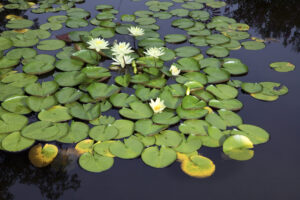
White Water lily plants produce up to 50 flowers annually with their strong scent. Producing fruit that resemble berries and contain seeds that can sink or float away, producing new plants. Their seeds provide food sources for various wetland birds such as Wood Ducks, Common Goldeneyes. Lesser Scaups and Sandhill Cranes and shelter for wetland-dwelling creatures like Muskrats.
Water lily plants are considered an invasive species in the US. Have caused serious problems to recreation and wildlife habitat. Their roots can clog boat motors. Limit access for non-motorized boats and create dense mats. Which block sunlight, raise temperatures and promote algal growth – as well as interfering with natural water flow patterns, leading to fish stress.
